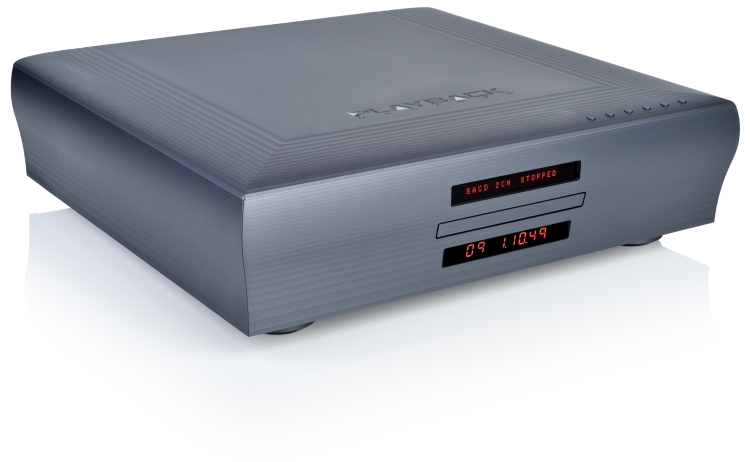AudioAanZee Ultra Flow Music Server
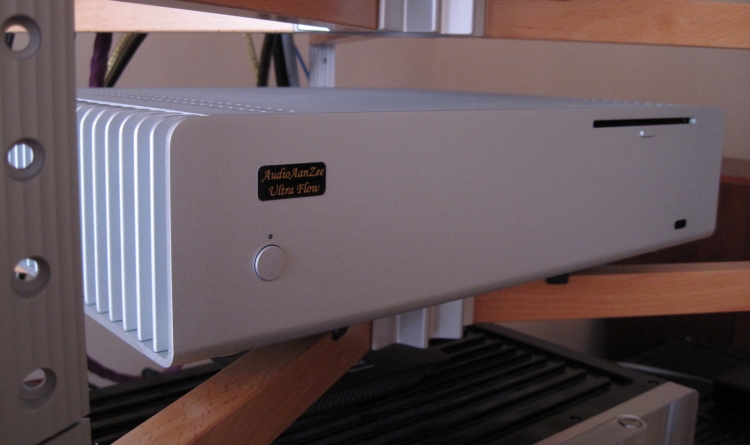
An affordable music server with a sublime user interface that challenges the best that I have heard. Interested? You should be!
Review sample supplied by AudioAanZee, developer of and dealer for the AAZ music servers
Premium Flow
One size cabinet (435x319x100 mm), 2 Tb, silver or black
€1499,-
Ultra Flow
One size cabinet (435x319x100 mm), 2 Tb, silver or black
€2199,-
Reference Flow
One size cabinet (435x319x100 mm), 2 Tb, silver or black
€2999,-
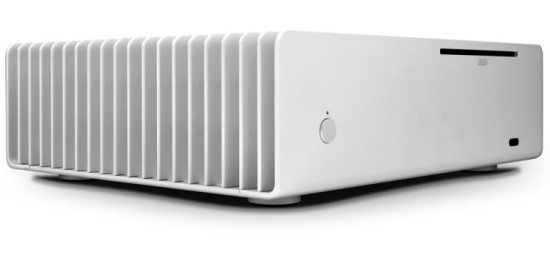
Introduction
The AAZ music server is available in several versions, in various price ranges. For this review I’ll concentrate on the best model: the AAZ Ultra Flow. The picture above is the 43.5 cm wide version but there’s also a narrower 34.8 cm version of this casing, which is pictured below.
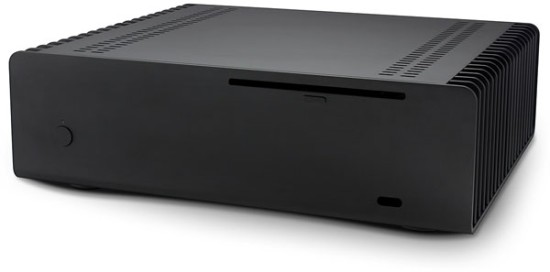
Streaming audio and computer audio have long been fields of special interest for me. I feel that I’ve come a long way since I pronounced computers inherently incapable of being as musical as high end CD players: devices such as Ayre QB-9, PS Audio PWD mkII, Linn Klimax DS/1 and more recently various Meridian Sooloos products have proven to me that there is indeed light at the end of the tunnel. I think that computer-based audio has matured rather quickly. What’s more: with careful setup and proper tuning 2012 was the year in which I could finally say that computer-based audio is a match for my favorite CD players in sound quality. I’m not saying that they sound exactly alike because they don’t. Good CD players still have a forgiving quality to them, which is perhaps rounding off as a result of error correction or the various stages of conversion going on inside. But be it coloration or not, computer audio for a long time hasn’t sounded as smooth or as fluid as my Mark Levinson 390S CD player.
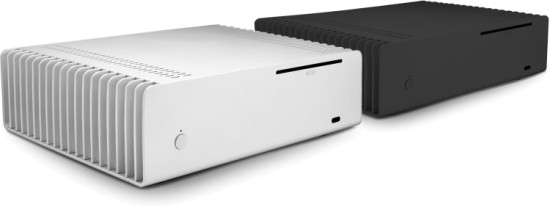
The Linn Klimax DS/0 already proved that streaming audio can sound as smooth while having better treble extension and air. The DS/1 went on to add to that a sound that was every bit as engaging as the Levinson, but it costs an arm and a leg. Well, two arms and two legs. Along came the top of the line Meridian 818 Reference Audio Core and that one managed to sound almost as good as the Klimax DS1 while simultaneously offering tremendously user-friendly operation. I was smitten. Concequently I purchased the Meridian MD600 and Meridian 818 which have served me well for about 4 months. The 818 did not quite sound as romantic as the Levinson 390S cd player, but it had much better resolution and treble extension and was every bit as fluid. I was happy with the sound. If it weren’t for a nasty bug in the Control:PC software (used for importing music on the MD600), I wouldn’t even have looked elsewhere. In short, importing partial albums (as opposed to complete rips) invariably result in wrong matches, necessitating me to fill in all the fields manually, in spite of perfect metadata. When this bug still wasn’t ironed out half a year and two updates later, I started looking elsewhere.
Enter the Audio Aan Zee Ultra Flow Music Server.
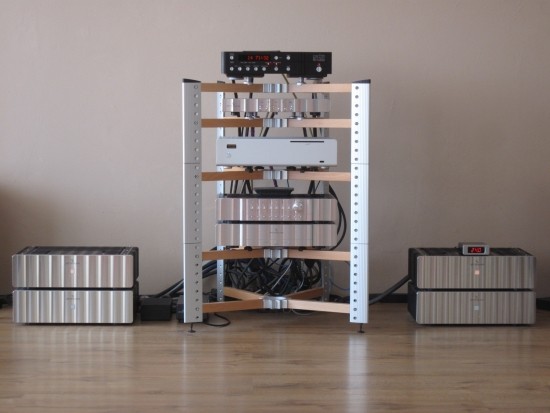
Good timing
Timing is everything they say, and it couldn’t have been better. Recently I was approached by a company that I hadn’t heard of until that moment: Audio Aan Zee. This translates loosely into Audio near the Sea, which is fitting because the audio shop is based in Den Helder, a coastal town in the Netherlands. AAZ not only sell audio equipment, they also design audio servers. Evert, the leading person, was inquiring whether I was interested in reviewing their latest product, the Audio Aan Zee Ultra Flow Music Server. Naturally I was interested, but I have to be honest: although I was expecting the system to sound nice, I wasn’t thinking that it would come close to my resident Meridian Sooloos system, (MD600 and 818 Reference Audio Core). By this time it was my firm belief that computers could very well make musical sounds, but that they needed to be embedded in specially designed closed systems, such as the Meridian Sooloos products. Sure I knew what was inside those boxes, and that it was far from exotic, but hey, these components managed to sound spectacular, so they must have done something right, that thus far seemed impossible to do with ordinary computer components.
Well, surprise! During the first listening tests with the AAZ Ultra Flow connected to the PS Audio PWD mkII, without any comparisons, I could already tell that this was something special.
Let me explain a little about this device. The AAZ Ultra Flow server is not a one in all solution in that it doesn’t contain a DAC, but it takes care of all other tasks involved. It has a built in automatic CD ripper that also categorises and fetches artwork, then stores the music on a noise-filtered 2TB hard disk that also runs the operating system. The latter is based on a stripped Fedora version of Linux. Evert told me that they have listened to countless variations on the scheme, using various motherboards and various operating systems (Windows, too) and that everything has an influence on the eventual sound quality. So minimised is the OS that it can in fact run without forced cooling. Output is on USB only, but not just any USB, we’re talking about the highly acclaimed “SOtM tX-USBexp”: a high end USB 3.0 PCIe card. The AAZ Ultra Flow is powered by an external power supply. This isn’t the usual small wall-wart variation but a proper power brick, capable of 16 amps! The power supply connects via a cable carrying 12 volts to a DC-DC board inside the server, where the various necessary voltages are produced. This makes for an electrically clean unit that doesn’t need any fans, not even in the power supply. What’s more: the unit comsumes very little energy and doesn’t get more than hand-warm.
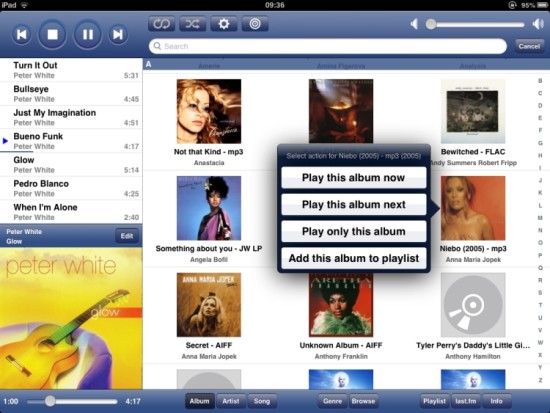
Above: Pad: the default action can be specified in settings: play now, play next, play only (deletes old playlist entries) and add to playlist. Additionally, various options appear after tapping and holding for one second.
Operation and mPad app
The unit is meant to run headless (no display/mouse/keyboard) and although it is possible to connect a screen and keyboard, this isn’t of much use as the operating system is command prompt only. Proper control over all its vital functions can be done much easier via logging in over ethernet using a web browser. By doing so you’re presented with a basic environment in which you can make some settings, then forget about altogether, unless you’re a reviewer like me, who likes to swap DACs regularly, which means you may have to manually select the one you want to use. But normally the system will be entirely plug and play.
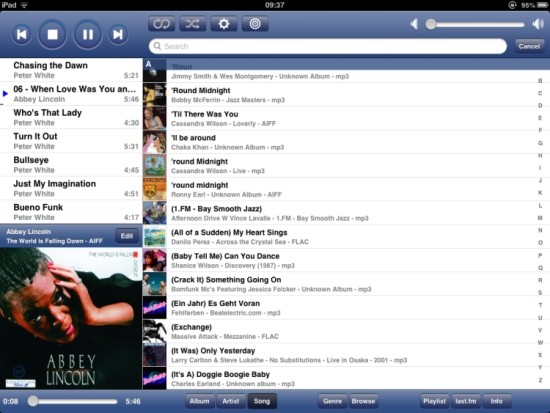
Above: Song view
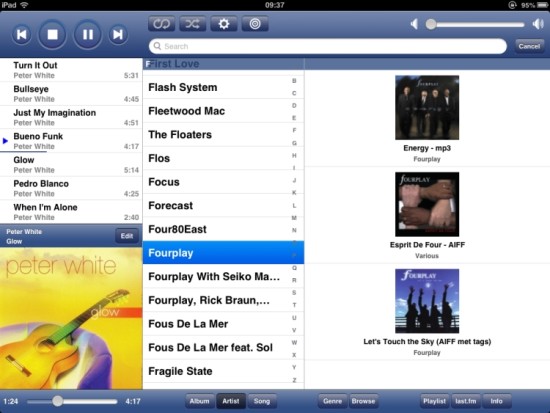
Above: Artist view
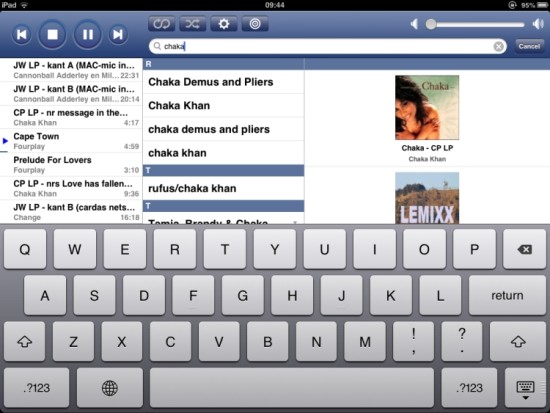
Above: Search view
Day to day operation (browsing, selecting, cueing and playing music) is done with an iPad, iPod or iPhone running a splendid 2,39 euro app called mPad/mPod that connects very quickly and seemlessly with Music Player Daemon (the music player software on the server). This app is so well thought out that it rivals my Sooloos iPad app in functionality and even beats it in speed. Because the app keeps an index of the music library on the i-device itself, browsing is blazingly fast, reminescent of the Aurender Music Server. This contrasts nicely with the Sooloos app, that has to connect to the disk server each time. Although the latter does also cache on the i-device to an extent, it doesn’t seem to be a full cache, as evident from the slow artwork build up and slower browsing. What is amazing is that the Sooloos system was devised to be speedy from the get go. For this to work, some sacrifices have had to be made. Still, response time (selecting and playing music) on the AAZ Ultra Flow is much faster than on my Sooloos system, without any of the aforementioned sacrifices no less! How about that?
Setup really is a breeze and is literally done before you can finish making a cup of espresso. Set-and-forget installation, a boot-up time of 16 seconds, super-speedy operation and blessed with excellent sound. What could you want more in a music server?
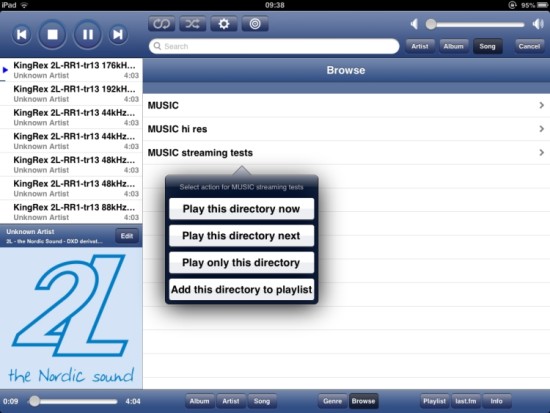
Above: Directory options
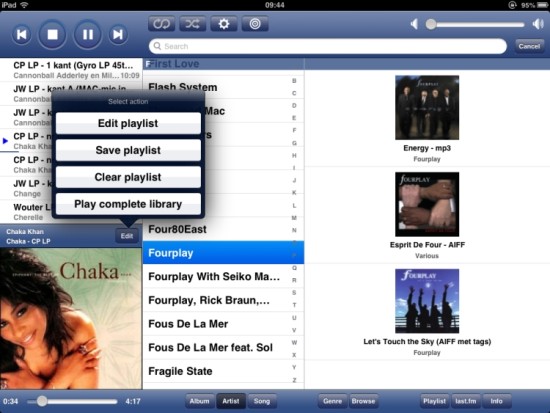
Above: Playlist options
The AudioAanZee Ultra Flow had now been playing music for several days but serious listening comparisons hadn’t commenced yet. For that occasion I invited an audio buddy for the evening and made all preparations before he arrived.
The AAZ Ultra Flow was initially setup on top of the Meridian 818 and later swapped over with the 818, sharing polar position on the rack as the components took turns during the comparisons. The AAZ Ultra Flow was fed by a Furutech Alpha 3 powercable, then connected with a KingRex uART-S USB cable to the PS Audio PWD mkII which was fed by a standard Lapp powercable. The Meridian Sooloos equipment was set up as usual: the 818 Reference Audio Core on top of the Spider rack, powered by a Gold Label powercable and the accompanying MD600 on the bottom of the Spider rack, with extra viscous rubber feet between the standard Spider rubber feet and the MD600’s bottom, powered by a smooth sounding Furutech FP3TS20 powercable, in an effort to negate the negative effects of being on the Spider’s bottom level. More about that will follow later. Both Sooloos units are connected to each other via a single UTP switch that in turn connects to the router permitting iPad operation. The AAZ Ultra Flow’s network cable was connected to the very same switch using the same brand and type of ethernet cable. But of course, for the AAZ Ultra Flow this doesn’t make a difference becaus its music playback happens inside the box, which is a reassuring thought, keeping the audible differences in UTP cables in mind. On both systems I had cued the same music (only AIFF files at first) and then left the system idle while I waited for the arrival of my audio buddy.
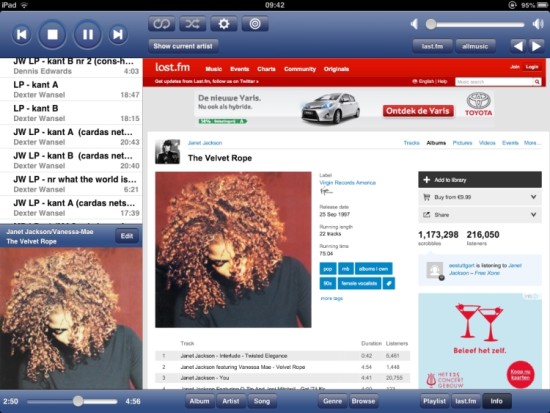
Above: Extra info about the currently playing album via LastFM or AMG
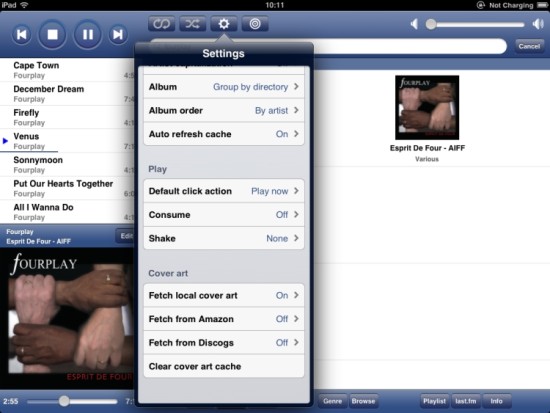
Above: Various options in settings, such as automatic artwork retrieval via Amazon or Discogs. Naturally the app will also pick up local artwork with a specified name such as Folder.jpg
After my audiobuddy arrived and we first had a nice meal, accompanied by a very nice bottle of wine (7 Deadly Zins Old Vine Zinfandel, personally imported from the ‘states) we were all set, totally relaxed and utterly curious to find out how the systems would compare.
With enormous anticipation I started the playback on both systems, made sure that they ran in sync, then lifted the mute on the preamp.
Even though I knew from the first hours of listening to the AAZ Ultra Flow that it sounded very good, I wasn’t prepared for what I was about to hear next when comparing it directly with the Sooloos combo. Regular readers know how I feel about the PWD MKII: I think it is an excellent performer but I have a problem with its treble coarseness (apparent lack of resolution) and lack of treble air and -extension. That is, until now. Would you believe that this particular problem is almost non existent when combined with the AAZ Ultra Flow? The PWD mkII now produces smooth, fluid and airy treble like I have never heard it do before. Switching back and forth between the Sooloos and the PWD mkII goes to solidify my initial feeling that the AAZ Ultra Flow is something special indeed. The difference is actually quite small. Both sources sound decidedly high end and not computer-esque, both have deep and solid bass, wide and deep soundstaging with superb central focus, excellent resolution and for the first time in my history with the PWD mkII, it doesn’t lose out in the treble.
There’s one area though that sticks out between the two and it’s not in favour of the Sooloos combo. Even though the Sooloos combo sounds utterly fluid, its midrange is sometimes a little hard or unforgiving. This is something I have noticed before lately but I attributed it to the change from summer to winter and after I did all that I could to offset this, I didn’t give it much more thought. But listening to the AAZ/PWD mkII combo makes this more obvious. The more I switch between the two, the more I feel that the Sooloos combo has an artificial ring to the midrange, and the more I like the AAZ Ultra Flow-PWD mkII combo.
Then I remembered that the MD600 (the server) used to be setup straight on the floor and that I had changed that to the bottom level of the Spider rack. At the time that gave me lots more pressure in the bass, along with a harder midrange, for which I had compensated using different powercables and rubber feet. Now that it was time to make for more closely matched comparisons, the MD600 would have to be treated the same way as the AAZ Ultra Flow: on the top level of the Spider rack. Removing it from the bottom level made an astonishingly big difference (how can that be-it’s only a server!) but I’ve heard this particular behaviour before when I installed a Marantz CD player on the bottom levels. Same thing happened: a stranglingly tight grip that prevented music to stream effortlessly. But let’s get back to the AAZ Ultra Flow. When it was set up in the prime position, the two setups were even more close to each other. So close in fact that it could be hard to tell which one was playing when switching quickly between the two. When listening for a couple of minutes though I could repeatedly recognisee small differences in presentation.
Then what are these differences you ask? Well, let me illustrate this by writing a little more about the Meridian combo. For me, their biggest plus is that the combo excells in fluidity. The music just flows out of the speakers in a very analog manner. Along with this fluidity, there’s a natural, smooth, extended treble that just has no added grain at all and seems to have eternal decay, if the recording permits. The combination of these aspects I had previously only ever heard before in the Linn Klimax DS1. It is on these aspects, that the PWDmkII has thus far performed less well. These weaker areas remain the weaker areas for the PWD mkII when combined with the AAZ Ultra Flow, but now they improve to the extent that one has to wonder if the differences are still meaningful. The AAZ Ultra Flow, by enabling the PWD mkII to sound better than it ever did, proves that the transport is just as important, perhaps even more important than the DAC itself. What’s more: the PWD mkII, used with its built-in Network Bridge, sounds coarse and dark by comparison. Can you believe that? In all the comparisons that I carried out before, the PWD always sounded best using its Network Bridge. SPDIF never was very good and USB, while certainly much better than SPDIF, was at best only ever as good as the Bridge, never better. Until now that is. Apparently the signal that’s delivered to the PWD mkII by the AAZ Ultra Flow is so clean and well-timed that the PWD mkII has no choice but to shine.
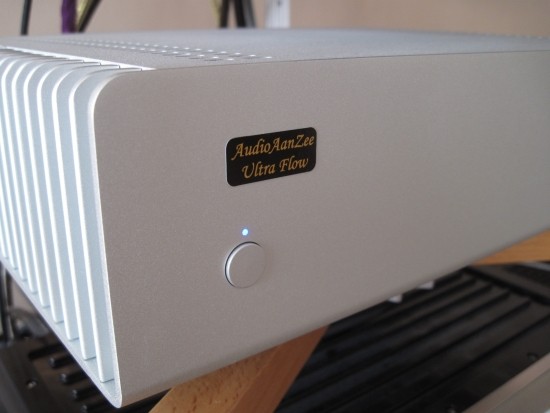
At this stage it may be interesting to indicate that all comparative listening was done using the KingRex uArt-S USB cable. The first hours after the AAZ Ultra Flow came in and I hadn’t started comparisons yet, I still had the excellent Audioquest Diamond USB cable in place. Comparisons between it and the KingRex showed that the Audioquest brought out greater apparent resolution in the PWD mkII. And that dear reader, will most likely be exactly what the doctor ordered! Oh, and remember: the MKII version of the PWD has two built-in digital lenses. And still, the quality of the delivered signal mattters. Yes, it’s a strange, strange audio world.
Oh, but it doesn’t end here. I explained what the PWD mkII does less well than the Meridian combo. But let’s look at what it does better! First and most obvious is the midrange. Somehow the AAZ/PWD mkII combo has a more natural and acoustically convincing midrange. Voices just sound more real and visceral, even if the Sooloos combo sounds louder in the midrange. But this loudness or forwardness does nothing for the authenticity, it actually takes a little away from natural sounds such as voices, piano and guitar making them sound somewhat pinched by comparison. And perhaps because of this forwardness in the midrange, the Sooloos combo sounds slightly more upbeat than the PWD mkII, but it also makes it sound like it is in a hurry all the time, even with music that’s supposed to be downtempo. I intentionally don’t say that it’s more upbeat than the AAZ in this case because I’m sure that this particular piece of character is actually 100% attributable to the PWD and not to the AAZ.
From recent memory, I’d even dare say that the AAZ Ultra Flow sounds more musical than the Aurender, when connected via USB to the very same PS Audio PWD mkII DAC. The Aurender was also spectacularly clean and well-resolved, but it was definitely less romantic, less fluid than the AAZ Ultra Flow.
At this stage I guess it’s clear where my preference lies: I actually prefer the AAZ Ultra Flow over the costly Meridian Sooloos solution and while it is in large part to do with the superb quality that the AAZ Ultra Flow delivers, this also ties in with the character of the DAC. Please keep in mind that the comparisons as described thus far were done with the PS Audio PWD mkII as a DAC. There are many, many USB DACs out there, and I’d wager that you should be able to tailor the AAZ Ultra Flow precisely to the sound you want, by choosing the appropriate DAC. That said, I did of course try the AAZ Ultra Flow with other DACs but none were even comparable to the PWD mkII. One is worth mentioning though: the dirt-cheap Audioquest DragonFly. This one managed to have even more refined treble and more fluidity than the PWD mkII, combined with a complete lack of artifice. Even if its soundstage wasn’t as wide, its bass not as solid and its dynamics not as large, the DragonFly only goes to demonstrate that the AAZ Ultra Flow is indeed a first-rate source. (and that the DragonFly is actually excellent given its low cost).
Perspective
I also listened to the AAZ Ultra Flow using a couple of other DACs: The AMR DP777 and the Ayre QB-9 (the latest 192khz version). Both offered an alternate set of qualities, quite different from the PS Audio and both worked very well, the AMR offering an overall smoother ride and the Ayre offering more air and openness in the mid to high frequencies but ultimately the best balanced match was found to be with the PWD MKII.
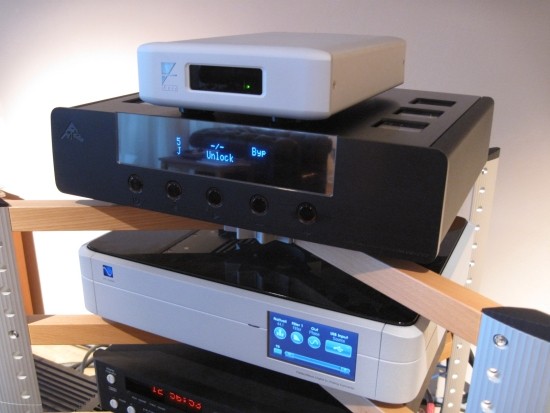
Conclusion
So there you have it: the affordable AAZ Ultra Flow, combined with the PS Audio PWD mkII, stacks up really well against even the best Sooloos offering. That’s a huge achievement as far as I’m concerned! But I’m sure many readers will now think “yes, but how does it stack up to Meridian’s famed Sooloos user experience?”. Well, the AAZ Ultra Flow’s mPad iPad app has got even that aspect covered. Actually: navigation on the iPad is A LOT quicker than on the Sooloos iPad Core Control app and just as intuitive. The super high speed is accomplished by caching the entire library on the iPad itself, so it doesn’t have to get its info from the server all the time. This works reminiscent to the Widealab Aurender. The mPad app may not offer entirely all the tagging that the Sooloos system is capable of, but it offers everything I need and combines it with the freedom to search/play by tags or by directory. But importantly, the AAZ Ultra Flow also frees one from the big constraint that a system like Sooloos imposes on the user: that of total freedom to copy to and from the server and use any naming convention/folder structure that takes your fancy. As long as your ID3 tags are sorted, the AAZ will work flawlessly. Oh, and it reads tagged AIFF files, too!
The AAZ Ultra Flow may be computer-based, but it is purpose-built and in fact far removed from any regular PC or Mac based solution. At best, those solutions sound like very good computer audio. The Ultra Flow, by comparison, has a specialised Linux operating system that caters only to the minimum of tasks and doesn’t waste resources on anything but music. The result is effortless, pure, natural music.
There’s more, a lot more in fact, to this system, like the built-in, automatical Ripping functionality that even sorts your artwork, the easy backup functionality and the squeezebox server as well as various optional software add ons, but my main focus is always on sound quality and I think that I’ve more than made my point in that regard by now!
Family matters
In addition to the AAZ Ultra Flow, there’s also a more affordable model called AAZ Premium Flow. Essentially, the latter is a less optimized AAZ Ultra Flow, with fewer tweaks, no hard disk filtering, no SOtM USB card, a simpler case and no internal damping. But the differences stop there. It runs the same software and has the same features and as such, at its low entry price, the AAZ Premium looks to be a super-bargain. For music lovers on a tight budget, the AAZ Premium Flow may well be the best option to go for. The AAZ Ultra Flow just takes it a few steps further, the moderate extra outlay buying you true state of the art sound.
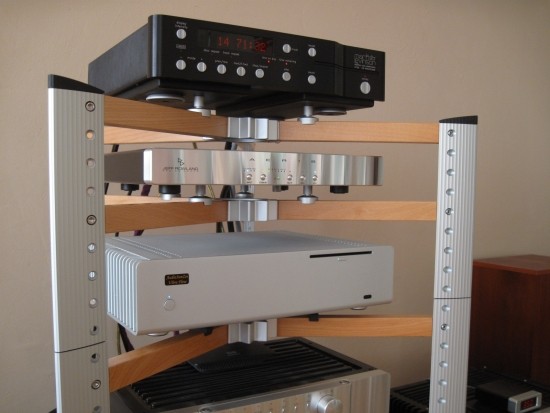
Addendum 16-3-2013
Recently I have reviewed the Jeff Rowland Aeris DAC. This DAC has me totally smitten. After reviewing it I couldn’t let it go and have now given it a permanent place in the system. The Aeris + AudioAanZee Ultra Flow represent nothing less than a magical combination, comfortably bettering the results I achieved when combining the AudioAanZee Ultra Flow with the PS Audio PWD MKII.
Side Note
The PWD MKII was used with older firmware version 2.0.2, which gives it a more relaxed character, in trade for a little of its Wadia-ness, ie: less solid bass and soundstaging, but still, it performs better in these areas than most of the competition.
